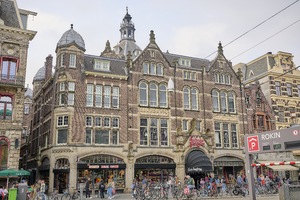It remains a mystery how Jacob van Oostsanen's Miracle Cloths ended up behind the wallpaper.
Location
Kapel ter Heilige Stede
Kalverstraat 87
Type
Chapel
Religious community
Former Roman Catholic Church
Object
Eight fragments of Jacob van Oostsanen's Miracle Cloth
Maker and date
Jacob Cornelisz van Oostsanen
1505-1518
Visit
On view until 8 September 2025 at Museum Ons' Lieve Heer op Solder
In 1845, in Amsterdam, a wall cupboard was discovered behind a door covered with wallpaper in the sacristy of the Nieuwezijds Kapel, once the Holy Stead. Not exactly an earth-shattering discovery: the contents of the cupboard are all the more so. Eight fragments emerge of what must once have been a canvas almost three-and-a-half meters wide. Placed in the right order, they tell the story of the Miracle of Amsterdam, which took place in 1345. How and when the fragments or the entire canvas ended up in the wall cupboard is and remains a mystery.
On 17 September 1566, iconoclasts tried to enter the Holy Stead. The 'overwives' of the Sacrament Guild — ladies of good family — put a stop to it. They would rather die for the good cause than have their chapel desecrated. Twelve years later, things don't end so well. On 26 May 1578, the Alteration took place and three days later the Holy Stead was besieged again. Everything that reminds us of the Miracle is destroyed. It is possible that the Miracle Cloth was damaged in such a way that the ladies of the guild wanted to save what could still be saved. The fragments do not bear the traces of reckless anger. The pieces are carefully cut out and the cuts follow the contours of the figures and the events that are part of the miracle story.
Jacob van Oostsanen lives in Kalverstraat, diagonally opposite the Holy Stead. One of his clients is the wealthy banker Pompeius Occo (1483-1537). From 1513 to 1519, he holds the position of churchwarden. He enriched the sanctuary with large donations. Is the cloth a gift from Pompey to the Holy Stead?
In 1765, city historian Jan Wagenaar saw another battered work of art: 'A few chunks of a dead-ended painting depicting the Miracle of the Holy Stead...'. The 'chunks' bear the handwriting of the first Amsterdam master painter Jacobus Cornelisz van Oostsanen (1470-1533). In terms of material and technique, the canvases are a one-off excursion for him. This may have to do with a possible function of the cloth, such as being able to be rolled up to hang on the outside of the chapel on special occasions.
Suzette van 't Hof
Staff member Collection, Information, Research and Publication Amsterdam Museum
Last edited
May 14, 2025
Het mirakel ter Heilige Stede, Jacob Cornelisz van Oostsanen, 1515, tempera on canvas. Collection Amsterdam Museum, on long-term loan from Amsterdam Protestant Church.
Exterior: photography Robert Westera.
Detail Het mirakel ter Heilige Stede, Jacob Cornelisz van Oostsanen, 1515, tempera on canvas. Collection Amsterdam Museum, on long-term loan from Amsterdam Protestant Church.
Portrait of Jacob Cornelisz van Oostsanen, studio of Jacob Cornelisz. van Oostsanen, c. 1533, Amsterdam. Collection Rijksmuseum Amsterdam.
Hof, S. van 't en S. Smit, Amsterdam in Gebed. Religieuze monumenten (Amsterdam 2005).
Meuwissen, D., Jacob Cornelisz van Oostsanen (ca. 1475-1533): De Renaissance in Amsterdam en Alkmaar (Zwolle 2014).









